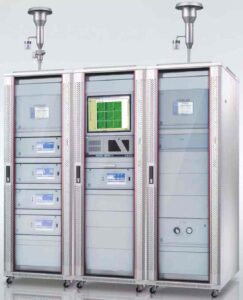ESE-AQMS-100 stands for gas analyzers in Air Quality Monitoring System. It is used to measure and analyze the levels of various pollutants in the air to assess air quality. These systems help monitor the impact of air pollution on the environment and public health.
Typical parameters measured by an AQMS include:
These measurements help identify air quality trends and ensure compliance with environmental standards.
| Parameter | Measurement Principle | Description |
|---|---|---|
| PM2.5 / PM10 | Optical Light Scattering/Beta Attenuation | Measures particulate matter concentration based on how particles scatter light or attenuate beta radiation. |
| NOx (Nitrogen Oxides) | Chemiluminescence | Detects NOx by measuring the light emitted during a chemical reaction with ozone. |
| SO2 (Sulfur Dioxide) | UV Fluorescence | Measures sulfur dioxide concentration by detecting fluorescence emitted when SO2 molecules are excited by UV light. |
| CO (Carbon Monoxide) | Non-Dispersive Infrared (NDIR) Absorption | Detects carbon monoxide based on the absorption of infrared light by CO molecules. |
| O3 (Ozone) | UV Absorption | Ozone absorbs UV light at specific wavelengths, allowing for concentration measurement. |
| VOC (Volatile Organic Compounds) | Photo-Ionization Detector (PID) / Flame Ionization Detector (FID) | VOCs are detected by ionizing them with UV light (PID) or using combustion (FID). |
The Auto & Continuous Ambient Air Quality Online Monitoring System is designed to track changes in the concentration of conventional pollutants such as SO2 , NOX , O3 , CO , and particulate matter (PM2.5 and PM10). Additionally, it can accommodate specialized pollutants like aerosols , VOCs , NH3 , and halides (HF/HCl) based on client requirements. By integrating with a Five Meteorological Parameters Analyzer —which measures temperature, humidity, wind direction, wind speed, and atmospheric pressure—the system enables continuous 24-hour online monitoring of the regional environment. This facilitates air quality assessment through comprehensive data collection, storage, and analysis.

Here’s a table showing the key measurement principles used in AQMS for various air quality parameters:
| Parameter | Measurement Principle | Description |
|---|---|---|
| PM2.5 / PM10 | Optical Light Scattering/Beta Attenuation | Measures particulate matter concentration based on how particles scatter light or attenuate beta radiation. |
| NOx (Nitrogen Oxides) | Chemiluminescence | Detects NOx by measuring the light emitted during a chemical reaction with ozone. |
| SO2 (Sulfur Dioxide) | UV Fluorescence | Measures sulfur dioxide concentration by detecting fluorescence emitted when SO2 molecules are excited by UV light. |
| CO (Carbon Monoxide) | Non-Dispersive Infrared (NDIR) Absorption | Detects carbon monoxide based on the absorption of infrared light by CO molecules. |
| O3 (Ozone) | UV Absorption | Ozone absorbs UV light at specific wavelengths, allowing for concentration measurement. |
| VOC (Volatile Organic Compounds) | Photo-Ionization Detector (PID) / Flame Ionization Detector (FID) | VOCs are detected by ionizing them with UV light (PID) or using combustion (FID). |
This table outlines the core principles used to measure common pollutants in air quality monitoring systems.
Measuring carbon dioxide (CO2) is important for understanding the role it plays in the environment and its effect on climate change. CO2 is a major component of Earth’s atmosphere, and it traps heat like a blanket, causing global temperatures to rise. Too m uch CO2 can lead to drastic changes in our weather patterns and ecosystems, so monitoring its levels is essential for predicting future climate conditions. Additionally, measuring CO2 can help us better understand our impact on the environment and make informed decisions about how to reduce emissions and slow down down down down down global warming. By analyzing CO2 data over time, we can develop strategies to mitigate the effects of climate change and ensure a sustainable future.
Before industrialization, the global average annual atmospheric carbon dioxide concentration was 278ppm (1ppm is one part per million). In 2012, the global annual average atmospheric carbon dioxide concentration was 393.1ppm. By April 2014 , the monthly average carbon dioxide concentration in the northern hemisphere atmosphere exceeded 400ppm for the first time. . 2. Global climate warming, the continuous aggravation of the atmospheric greenhouse effect leads to global climate warming, resulting in a series of global climate problems that cannot be predicted by today’s science. According to the International Climate Change Economics Report, if human beings maintain the current way of life, by 2100, there will be a 50% chance that the global average temperature will rise by 4°C.
Copyright © 2023 esegas.com, All rights reserved.


Enviro Solutions Technology Co., Ltd (ESE Technology) is a gas analyzer manufacturer and leading provider in ODM/OEM services for gas analysis systems used by international famous brands.
We will contact you within 1 working day, please pay attention to the email with the suffix “[email protected]” .
We’ll send you the catalog as soon as you submit your email